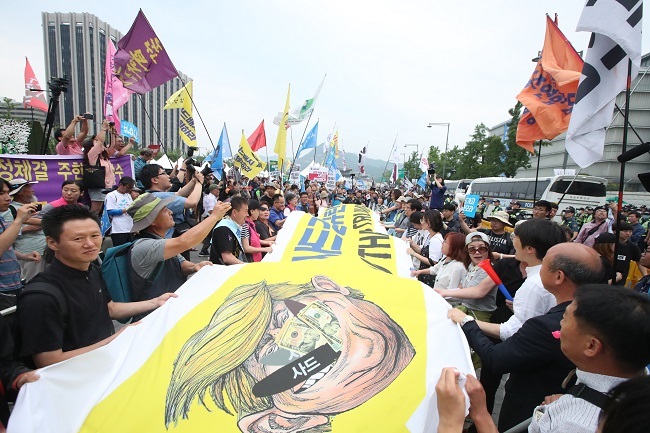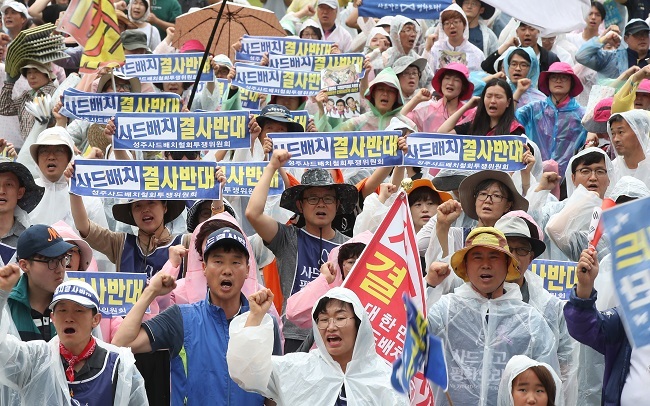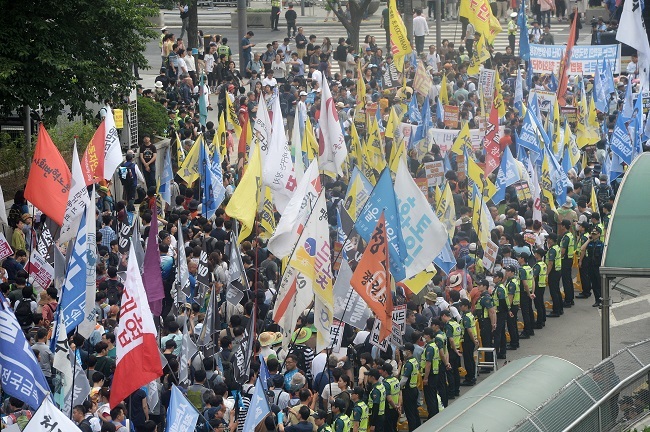[From the scene] Trump, fury, misunderstanding drive THAAD protest
By Ock Hyun-juPublished : June 25, 2017 - 15:48
An estimated 3,000 people chanted in unison “Retract the deployment of THAAD” and “THAAD out. Peace in.” Some were carrying placards reading “Koreans Hate THAAD” or “No THAAD, No Trump.” They were accusing Washington of “forcing” Seoul to station a Terminal High Altitude Area Defense battery here, which they say caters only to US interests while driving a wedge between South Korea and China.
Though they have the common goal of yanking THAAD out of their homeland, the motives that brought them together differed -- from deep-seated anti-US sentiment to hatred of US President Donald Trump to hopes for Seoul’s greater role in relations with Washington and Pyongyang.

"We have not been able to say ‘No’ to the US for too long. I am here because I am angry about the government not saying ‘No’ to THAAD, which I think raises tensions on the Korean Peninsula,” Lee Ki-ja, 76, said, calling the Korea-US alliance “unbalanced.”
“We cannot be victimized by a confrontation among powerful countries like the US, China and Russia,” said Lee, who herself lived through the 1950-1953 Korean War and the ensuing Cold War between the US and Soviet Union.
Most of the participants of the rally were affiliated with some 90 labor unions, civic groups and far-left political parties demanding the Korean government pursue more independent foreign policy without being swayed by its powerful allies and neighbors.
The protest came as South Korea’s new president Moon Jae-in heads to Washington this week for his first summit with Trump. But instead of the North’s nuclear and missile program topping the agenda as expected, the THAAD issue has been overshadowing the crucial trip after Cheong Wa Dae suspended the installment of four launchers, citing the need of an environmental review.
While Washington was seen displaying discomfort, the surprise decision appeared to have emboldened the civic organizations that not long ago engineered massive demonstrations that culminated in the impeachment of former President Park Geun-hye and led to the election of Moon as the commander-in-chief.
The protestors’ emotional response to THAAD reflects a longstanding anti-US sentiment, which has been highlighted in major protests following the 2002 death of two South Korean teenage girls by a US military vehicle and a 2008 bilateral deal to import US beef despite safety concerns.
With 28,500 US troops stationed here, the two countries’ alliance was forged on a mutual defense treaty dating to the end of the Korean War in 1953. Though most South Koreans have respect for the US as a security provider, there are also anti-US factions who blame the US for the division on the peninsula and view it as an obstacle to reunification.

According to a Gallup Korea survey of 1,003 Koreans released on June 16, 53 percent of the 1,003 respondents were in favor of the stationing of THAAD, while 32 percent were against it. Nearly half the THAAD supporters believed THAAD was a defense system for national security and safety. Some 22 percent said it would contain North Korea’s nuclear provocations.
Some of the protestors, however, went as far as to demand US forces be withdrawn from Korea and the country get back the operational command of wartime forces as a sovereign state. They believe that stopping THAAD would symbolize the country’s shift from “reliance” on the US to an independent course over its diplomacy.
“I want the US military to be drawn out of our country,” Lim Jae-woo, a 23-year-old university student said. “I am opposing the US, which intervenes in our state affairs. I believe THAAD is to protect the interests of the US and Japan.”
Other protestors questioned the process of the THAAD deployment. Its earlier-than-scheduled deployment before President Moon was sworn in has been pointed to by opposition lawmakers as being “politically motivated.” They called for parliamentary approval for the deployment.
“As controversy persists over the deployment of THAAD, the government should go through legitimate procedures to reconsider whether it will be deployed here or not,” said Song Myung-sik, while marching around the US Embassy. “I hope he addresses this issue on behalf of Koreans during the upcoming summit.”
The Moon government recently halted the deployment of the remaining four launchers until a full environmental-impact assessment is completed. He underscored the importance to ensure “domestic law and regulations are properly enforced” during an interview with Reuters last week. He also said that the deployment has been “mysteriously accelerated,” though the allies had agreed to station only one launcher this year.
Also among the participants were residents living in and near Seongju, North Gyeongsang Province, where the system is being deployed. Nearby residents are worried about health and environmental risks from electromagnetic waves emitted by its AN/TPY-2 radar system in their neighborhood.
Their opposition to THAAD is also based on lingering doubts over the effectiveness of the anti-missile system in protecting South Koreans. As it is being deployed in Seongju, they question whether it could deter the North’s short-range missiles targeting Seoul and its surrounding area.
“When it is not to protect Koreans’ lives, why should we have it here? The South Korean government should put Koreans’ interest first. It is our loss, given economic retaliation from our main trading partner China,” said Lee Cheon-dong, secretary-general of the Veterans for Peace Association.
China has said the system’s radar could be used to spy into its territory and undermine regional security. It responded with what appear to be economic retaliations against South Korea through restrictions on Korean companies’ business with and in China.

The protestors marched from Seoul Square in front of City Hall to the US Embassy and demonstrated there for about 20 minutes, creating a 580-meter “human chain.” The march was held in a peaceful manner, with no clashes or violence at the scene. Some 4,700 police officers were dispatched around the embassy building.
The rally targeting the US Embassy was initially not permitted by police. A local court later ordered it to cancel the ban and allowed protesting near the embassy only for 20 minutes.
Despite the anti-THAAD sentiment during the rally, not all in the area were against the deployment.
“I think they can dispute the process of hurriedly deploying THAAD, but it is already in our country and it is not really a good time to raise this issue in the wake of North Korea’s provocations,” said Kim Ji-hoon, a 30-year-old office worker who was walking past the anti-THAAD rally.
“I am particularly against the calls for the end of the Korea-US alliance. The alliance is necessary to keep peace on the Korean Peninsula.”
By Ock Hyun-ju (laeticia.ock@heraldcorp.com)
-
Articles by Ock Hyun-ju






![[From the Scene] Monks, Buddhists hail return of remains of Buddhas](http://res.heraldm.com/phpwas/restmb_idxmake.php?idx=644&simg=/content/image/2024/04/19/20240419050617_0.jpg&u=20240419175937)








![[From the Scene] Monks, Buddhists hail return of remains of Buddhas](http://res.heraldm.com/phpwas/restmb_idxmake.php?idx=652&simg=/content/image/2024/04/19/20240419050617_0.jpg&u=20240419175937)

![[KH Explains] Hyundai's full hybrid edge to pay off amid slow transition to pure EVs](http://res.heraldm.com/phpwas/restmb_idxmake.php?idx=652&simg=/content/image/2024/04/18/20240418050645_0.jpg&u=20240419100350)

![[Today’s K-pop] Illit drops debut single remix](http://res.heraldm.com/phpwas/restmb_idxmake.php?idx=642&simg=/content/image/2024/04/19/20240419050612_0.jpg&u=)